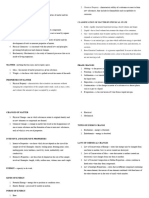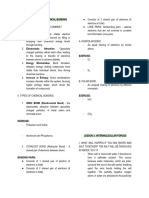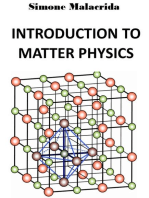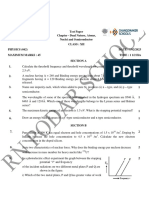0 ratings0% found this document useful (0 votes)
10 viewsSTM 6 Chem
STM 6 Chem
Uploaded by
kaba.contaoi.up1. The document discusses various intermolecular and intramolecular forces including van der Waals forces, dipole-dipole interactions, London dispersion forces, hydrogen bonding, and ionic forces.
2. It also covers the kinetic molecular theory of matter and states that matter is made up of particles in constant motion, with the phase of matter depending on the temperature and average kinetic energy of particles.
3. The kinetic molecular theory further explains that intermolecular attractive forces become stronger as particles move closer together.
Copyright:
© All Rights Reserved
Available Formats
Download as DOCX, PDF, TXT or read online from Scribd
STM 6 Chem
STM 6 Chem
Uploaded by
kaba.contaoi.up0 ratings0% found this document useful (0 votes)
10 views3 pages1. The document discusses various intermolecular and intramolecular forces including van der Waals forces, dipole-dipole interactions, London dispersion forces, hydrogen bonding, and ionic forces.
2. It also covers the kinetic molecular theory of matter and states that matter is made up of particles in constant motion, with the phase of matter depending on the temperature and average kinetic energy of particles.
3. The kinetic molecular theory further explains that intermolecular attractive forces become stronger as particles move closer together.
Original Title
stm6chem
Copyright
© © All Rights Reserved
Available Formats
DOCX, PDF, TXT or read online from Scribd
Share this document
Did you find this document useful?
Is this content inappropriate?
1. The document discusses various intermolecular and intramolecular forces including van der Waals forces, dipole-dipole interactions, London dispersion forces, hydrogen bonding, and ionic forces.
2. It also covers the kinetic molecular theory of matter and states that matter is made up of particles in constant motion, with the phase of matter depending on the temperature and average kinetic energy of particles.
3. The kinetic molecular theory further explains that intermolecular attractive forces become stronger as particles move closer together.
Copyright:
© All Rights Reserved
Available Formats
Download as DOCX, PDF, TXT or read online from Scribd
Download as docx, pdf, or txt
0 ratings0% found this document useful (0 votes)
10 views3 pagesSTM 6 Chem
STM 6 Chem
Uploaded by
kaba.contaoi.up1. The document discusses various intermolecular and intramolecular forces including van der Waals forces, dipole-dipole interactions, London dispersion forces, hydrogen bonding, and ionic forces.
2. It also covers the kinetic molecular theory of matter and states that matter is made up of particles in constant motion, with the phase of matter depending on the temperature and average kinetic energy of particles.
3. The kinetic molecular theory further explains that intermolecular attractive forces become stronger as particles move closer together.
Copyright:
© All Rights Reserved
Available Formats
Download as DOCX, PDF, TXT or read online from Scribd
Download as docx, pdf, or txt
You are on page 1of 3
STM 006: General Chemistry 2
MODULE 1 INTERMOLECULAR Force between molecules.
FORCES (IMF’s) - Forces of attraction or
CHEMISTRY Study of matter—what it consists of,
(CENTRAL what its properties are, and how it repulsion which act between
SCIENCE) changes. neighboring particles (atoms,
molecules, or ions).
- Part of biology and physics.
INTRAMOLECULA Force within a molecule.
CHEMIST Scientist trained in the study of
R FORCES
chemistry.
KINETIC ENERGY Energy of an object as it is in
BIOCHEMISTRY Biologists and chemists work in both
motion.
fields.
The slower the particles in a substance move, the colder it
GEOCHEMISTRY Geology and chemistry overlap in
is.
the field.
MODULE 3
MATTER Anything that has mass and takes
up space—that is, anything that is
physically real.
ATOM Smallest particle of matter.
ELEMENT Pure chemical substance consisting
of a single type of atom.
STATES OF MATTER
SOLID Matter with definite shape, mass,
and volume.
LIQUID Matter without definite shape, but
with definite volume.
GAS Matter without definite shape, mass,
and volume. VAN DER Also known as LDF.
PHASE CHANGES OF MATTER WAALS - Includes attraction and repulsions
FORCES between atoms, molecules, and
EVAPORATION Liquid to Gas
surfaces, as well as other
CONDENSATION Gas to Liquid intermolecular forces.
SUBLIMATION Solid to Gas DIPOLE- Occur when the partial charges
CARBON Most common form of burning in DIPOLE formed within one molecule are
COMBUSTION everyday life. INTERACTIONS attracted to an opposite partial charge
in a nearby molecule.
MODULE 2 - POLAR MOLECULES align so
KINETIC Offers a description of the that the positive end of one
MOLECULAR microscopic properties of atoms (or molecule interacts with the
THEORY molecules) and their interactions, negative end of another molecules.
leading to observable macroscopic LONDON Temporary attractive force that results
properties (such as pressure, DISPERSION when the electrons in two adjacent
volume, temperature). FORCE atoms occupy positions that make the
- Helps explain why matter exists in atoms form temporary dipoles.
different phases (solid, liquid, and - Sometimes called an INDUCED
gas) and how matter can change DIPOLE-INDUCED DIPOLE
from one phase to the next. ATTRACTION.
KINETIC MOLECULAR THEORY OF MATTER - London forces are the attractive
forces that cause NONPOLAR
1. MATTER is made up of particles that are constantly
substances to condense to liquids
moving.
and to freeze into solids when the
2. All PARTICLES have energy, but the ENERGY
temperature is lowered sufficiently.
varies depending on the temperature the sample of
matter is in. This in turn determines whether the POLAR Occur when there is an
substance exists in the solid, liquid, or gaseous state. MOLECULES electronegativity difference between
Molecules in the SOLID phase have LEAST amount the bonded atoms.
of energy, while GAS particles have the GREATEST NONPOLAR Occur when electrons are shared
amount of energy. MOLECULES equal between atoms of a diatomic
3. The TEMPERATURE of a substance is a measure of molecule or when polar bonds in a
the average kinetic energy of the particles. larger molecule cancel each other
4. A CHANGE IN PHASE may occur when the energy out.
of the particles is changed.
5. There are SPACES between particles of matter. The HYDROGEN Attractive force between the hydrogen
average amount of empty space between molecules BONDING attached to an electronegative atom
gets progressively LARGER as a sample of matter (POLAR) of one molecule and an
moves from the solid to liquid and gas phases. electronegative atom of a different
6. There are ATTRACTIVE FORCES between atoms/ molecule.
molecules, and these become STRONGER as the - Usually the electronegative atom is
particles move CLOSER together. These attractive OXYGEN, NITROGEN, OR
forces are called INTERMOLECULAR FORCES. FLUORINE, which has a partial
STM 006: General Chemistry 2
negative charge. SOLIDS Characterized by an extended
three-dimensional arrangement of
As bonds become more POLARIZED, the charges on the
atoms, ions, or molecules in which
atoms become GREATER, which leads to GREATER
the components are generally
molecular attractions, which leads to HIGHER boiling
locked into their positions.
points.
- Components can be arranged in
IONIC FORCE Interactions between charged atoms or a regular repeating three-
molecules. dimensional array (crystal
CATIONS Positively charged ions. lattice), which results in a
crystalline solid, or more or less
ANIONS Negatively charged ions.
randomly to produce an
COULOMB’S Attractive forces between oppositely amorphous solid.
LAW charged ions.
CRYSTALLINE Have well-defined edges and faces,
- Forces INCREASES with charge SOLIDS diffract x-rays, and tend to have
and DECREASES as the distance (CRYSTALS) sharp melting points.
between these ions is INCREASED.
- Have distinctive internal
- The LARGER the molar mass (in some cases), the structures that in turn lead to
STRONGER the IMFs. distinctive flat surfaces, or faces.
- MORE HYDROGEN BONDS means STRONGER IM - Faces intersect at angles that
FORCE. are characteristic of the
WEAKEST TO 1. London Dispersion Force substance.
STRONGEST 2. Dipole-Dipole - When exposed to x-rays, each
ATTRACTION 3. Hydrogen Bonding structure also produces a
distinctive pattern that can be
MODULE 4 used to identify the material.
LIQUID STATE OF MATTER AMORPHOUS Have irregular or curved surfaces,
1. Intermediate phase between solid and gas. SOLIDS do not give well-resolved x-ray
2. Particles in a liquid are subject to molecular diffraction patterns, and melt over a
attraction. wide range of temperatures.
3. Particles have more space between them, so they - When cleaved or broken, they
are not fixed in position. produce fragments with irregular,
4. Attraction between the particles in a liquid keeps the often curved surfaces; and they
volume of the liquid constant. have poorly defined patterns
5. Movement of the particles causes the liquid to be when exposed to x-rays because
variable in shape. their components are not
6. Liquids will flow and fill the lowest portion of a arranged in a regular array.
container, taking on the shape of the container but - Almost any substance can
not changing in volume. solidify in amorphous form if the
7. The limited amount of space between particles liquid phase is cooled rapidly
means that liquids have only very limited enough.
compressibility. GLASS Amorphous translucent solid.
EVAPORATION Process of changing from a liquid CRYSTALLINE SOLIDS AMORPHOUS SOLIDS
or solid state into vapor (like fog,
mist, or steam). Definite and regular Arranged irregularly and
geometry and have long do not have any definite
BOILING POINT Temperature at which the vapor range as well as short geometry and have short
pressure of a liquid equals the range order range order
pressure surrounding the liquid and
the liquid changes into a vapor. High melting points Devoid of sharp melting
- Liquid in a partial vacuum has a points
lower boiling point than when External forms have No external regularity
that liquid is at atmospheric regularity when formed when formed
pressure.
Clean surface after Exhibit irregular cut
VAPOR Measure of the tendency of a cleavage with knife
PRESSURE material to change into the gaseous
Definite heat of fusion Do not possess any
or vapor state, and it increases with
particular heat of fusion
temperature.
Very rigid and molecules Do not exhibit rigidity and
SURFACE Property of the surface of a liquid
cannot be deformed by deformation could be
TENSION that allows it to resist an external
mild distorting fore done by bending or
force, due to the cohesive nature of
compressing them
the water molecules.
True solid Super cooled liquids or
COHESIVE If the IMFs between LIKE
also pseudo solids
FORCES molecules are strong, the drop of
liquid is maintained. Anisotropism Isotropism
ADHESIVE If the forces between UNLIKE CRYSTALLINE FACES Intersect at right angles.
FORCES molecules are strong, the liquid is CLEAVING A CRYSTAL Deformation of the ionic
said to the wet the surface. OF AN IONIC crystal causes one plane of
MODULE 5 COMPOUND ALONG A atoms to slide along
PLANE OF IONS anther. The resulting
STM 006: General Chemistry 2
repulsive interactions
between ions with like
charges cause the layers to
separate.
LATTICE OF Atoms form a regular
CRYSTALLINE QUARTZ arrangement in a structure
(SiO2) that consists of linked
tetrahedra.
CLEAVAGE SURFACES Tend to have curved,
OF AN AMORPHOUS irregular surfaces when
SOLID cleaved.
MODULE 7
SOLUTION Homogeneous mixture
composed of two or more
substances.
- In such a mixture, a
SOLUTE is a substance
dissolved in another
substance, known as
SOLVENT.
SOLVENT Component that is present
in greater quantity.
- Determines the state of
matter in which the
solution exists.
SOLUTE Component in lesser
quantity.
Types of Solute Solvent Example
Solution
GASEOUS Gas Gas Air
SOLUTION
LIQUID Gas Liquid Carbonated Drinks
SOLUTION Liquid Liquid Alcohol in water
Solid Liquid Syrup
SOLID Gas Solid Hydrogen in
SOLUTION Liquid Solid Palladium metal
Solid Solid Amalgam (mercury
and silver, brass,
steel)
CONCENTRATION Refers to the amount of
solute in a solution or
solvent.
WATER Universal solvent
- Its molecules have a
polar arrangement of
oxygen and hydrogen
atoms—one side
(hydrogen) has a
positive electrical charge
and the other side
(oxygen) has a negative
charge. This allows the
water molecule to
become attracted to
many other different
types of molecules.
You might also like
- Pearson Edexcel A Level Chemistry Year 1 and Year 2Document667 pagesPearson Edexcel A Level Chemistry Year 1 and Year 2Rameesha Malik100% (1)
- General Chemistry 1 An Atomic View of Matter Module 5.1 PDFDocument27 pagesGeneral Chemistry 1 An Atomic View of Matter Module 5.1 PDFHello Hi0% (1)
- Kinetic Molecular ModelDocument3 pagesKinetic Molecular ModelChristine FernandezNo ratings yet
- First Quarter: Week - 1: General ChemistryDocument9 pagesFirst Quarter: Week - 1: General ChemistryPerlyn Del Pilar OduyaNo ratings yet
- GenChem 2 ReviewerDocument13 pagesGenChem 2 ReviewerPia Aure MartinezNo ratings yet
- Gen Chem 2 RevDocument3 pagesGen Chem 2 RevpineraynaangelaNo ratings yet
- Gen - Chem 11 Solids and LiquidsDocument13 pagesGen - Chem 11 Solids and Liquidschasesawadjaan142No ratings yet
- Q3 General Chemistry 2Document12 pagesQ3 General Chemistry 2nikxsxsxNo ratings yet
- Notes 3rd QuarterDocument36 pagesNotes 3rd QuarterKent DanielNo ratings yet
- Angel - Physical ScienceDocument10 pagesAngel - Physical ScienceMaria Dhalia MarquezNo ratings yet
- Intermolecular Forces: Self-Learning Module (SLM) General Chemistry 2 Quarter 3 - Module 1 - AY 2021 - 2022Document6 pagesIntermolecular Forces: Self-Learning Module (SLM) General Chemistry 2 Quarter 3 - Module 1 - AY 2021 - 2022almafebe caselNo ratings yet
- Kinetic Molecular Model of Liquids and Solids & Intermolecular ForcesDocument9 pagesKinetic Molecular Model of Liquids and Solids & Intermolecular ForcesJeromeNo ratings yet
- Notes GenchemDocument7 pagesNotes Genchemkennrapsing14No ratings yet
- CBE-3-Organic-and-Inorganic-ChemistryDocument3 pagesCBE-3-Organic-and-Inorganic-ChemistryREGINA MAE JUNIONo ratings yet
- Module 1Document4 pagesModule 1welpNo ratings yet
- Science ReviewerDocument8 pagesScience ReviewerIT'S JAY STEPHEN0% (1)
- Gen Chem 2 ReviewerDocument2 pagesGen Chem 2 ReviewerDrake AlzonaNo ratings yet
- General Chemistry 2 ReviewerDocument4 pagesGeneral Chemistry 2 ReviewerDeill UrdasNo ratings yet
- C2-Chemical Basis of LifeDocument2 pagesC2-Chemical Basis of LifeLorrine MagramoNo ratings yet
- INTERMOLECULAR-FORCESDocument10 pagesINTERMOLECULAR-FORCESZane MagauayNo ratings yet
- Intermolecular ForcesDocument37 pagesIntermolecular ForcesJohnnardBelenNo ratings yet
- Lesson 1 Kinetic Molecular Model of Solid and LiquidDocument4 pagesLesson 1 Kinetic Molecular Model of Solid and LiquidJohanna Rachel S. VillasisNo ratings yet
- Genchem 2 NotesDocument20 pagesGenchem 2 Notesmoss headNo ratings yet
- CHEMISTRY 3rd Quarter ReviewerDocument9 pagesCHEMISTRY 3rd Quarter ReviewerJanelle NopuetoNo ratings yet
- GENERAL CHEMISTRY 2 MIDTERMS 1ST SEMESTERDocument3 pagesGENERAL CHEMISTRY 2 MIDTERMS 1ST SEMESTERcedrikabianNo ratings yet
- Stem Synergy ChemistryDocument12 pagesStem Synergy Chemistrysapphireraicyn143No ratings yet
- vt59.2708-21379314948 845711993629263 4743171499632753126 n.pdfPHY-SCI-LES-3.pdf NC Cat 109&ccb 1-7& NDocument43 pagesvt59.2708-21379314948 845711993629263 4743171499632753126 n.pdfPHY-SCI-LES-3.pdf NC Cat 109&ccb 1-7& Nbd57ppgspjNo ratings yet
- Gaseous StateDocument20 pagesGaseous Statetekari9549No ratings yet
- States of Matter: Unit 5Document24 pagesStates of Matter: Unit 5rekha_1234No ratings yet
- 1 - ChemistryDocument17 pages1 - ChemistryJOANA ESTINOCONo ratings yet
- Q3 General Chemistry IiDocument3 pagesQ3 General Chemistry IiStephen Karl De GuzmanNo ratings yet
- CH 6. State of Matter (Chem +1) PDFDocument46 pagesCH 6. State of Matter (Chem +1) PDFDeepak KumarNo ratings yet
- Ncert ch5 Chemistry Class 11Document22 pagesNcert ch5 Chemistry Class 11Karan ManglaNo ratings yet
- Lecture 3 - States of Matter (Chemy)Document64 pagesLecture 3 - States of Matter (Chemy)NUR EZZAIFAH BINTI AKBAR NAWAB FS21110068No ratings yet
- Trans Organic Chemistry Chapter3Document3 pagesTrans Organic Chemistry Chapter3jilldlrs06No ratings yet
- Chemistry 2Document7 pagesChemistry 2Marie Angelie KilarioNo ratings yet
- Imelda B. Corpuz, RPH, MSPHDocument49 pagesImelda B. Corpuz, RPH, MSPHAdzrina AhmadNo ratings yet
- CBSE Class 11 NCERT Book Chemistry Part 1 STATES of MATTER Chapter 5Document24 pagesCBSE Class 11 NCERT Book Chemistry Part 1 STATES of MATTER Chapter 5NishantNo ratings yet
- States of Matter: Unit 5Document24 pagesStates of Matter: Unit 5RahulNo ratings yet
- The Kinetic Molecular ModelDocument9 pagesThe Kinetic Molecular ModelSaralyn Mawallil AmilhamjaNo ratings yet
- 1Q - Week 3 Physical ScienceDocument14 pages1Q - Week 3 Physical ScienceJEBONIE TUBICE100% (1)
- States of Matter: Unit 5Document24 pagesStates of Matter: Unit 5Harsh VardhanNo ratings yet
- Kinetic Molecular TheoryDocument6 pagesKinetic Molecular TheoryJM FelixNo ratings yet
- Q3 Lesson 1 - CDocument3 pagesQ3 Lesson 1 - CCamille Guzman CabisoNo ratings yet
- Chem SLHT 1Document4 pagesChem SLHT 1lara salundaguitNo ratings yet
- PhySci ReviewerDocument5 pagesPhySci ReviewerbanabancyrellNo ratings yet
- Nesrine-Unit2.Matter, Chemical Reactions, and SolutionsDocument32 pagesNesrine-Unit2.Matter, Chemical Reactions, and SolutionsMie NgeNo ratings yet
- UntitledDocument140 pagesUntitledPoojitha kamarajNo ratings yet
- General Chemistry Ii: Senior High SchoolDocument5 pagesGeneral Chemistry Ii: Senior High SchoolJerry De Leon TaayNo ratings yet
- Module 1Document45 pagesModule 1Leigh Kyster BenlotNo ratings yet
- Intramolecular Forces (Chemical Bonding) : Ionic BondDocument27 pagesIntramolecular Forces (Chemical Bonding) : Ionic BondVince ShaneNo ratings yet
- What Is MatterDocument7 pagesWhat Is MatterpinieraaurapaulaNo ratings yet
- UntitledDocument14 pagesUntitledNana MinNo ratings yet
- Chapter 4. Part 1Document24 pagesChapter 4. Part 1aly.darghouthNo ratings yet
- PhySci ReviewerDocument5 pagesPhySci ReviewerAryannaNo ratings yet
- WEEK 1 HandoutDocument10 pagesWEEK 1 HandoutWeCareNo ratings yet
- General Chemistry IIDocument8 pagesGeneral Chemistry IIJoven EstebanNo ratings yet
- Module 1 - KINETIC MOLECULAR THEORY, IMF, AND PROPERTIES OF LIQUIDDocument5 pagesModule 1 - KINETIC MOLECULAR THEORY, IMF, AND PROPERTIES OF LIQUIDGabo AlfonsoNo ratings yet
- Eng EconoDocument7 pagesEng EconoDUMAGCAO, LAURENCE ROBERT R.No ratings yet
- A-Level Chemistry Revision: Cheeky Revision ShortcutsFrom EverandA-Level Chemistry Revision: Cheeky Revision ShortcutsRating: 4 out of 5 stars4/5 (5)
- What is Charge? – The Redefinition of Atom - Energy to Matter ConversionFrom EverandWhat is Charge? – The Redefinition of Atom - Energy to Matter ConversionNo ratings yet
- Phyy 4Document78 pagesPhyy 4Sajjad FaisalNo ratings yet
- Atomic Structure 14421Document5 pagesAtomic Structure 14421Aliraza76No ratings yet
- ACTIVITY SHEET in Science 9 Wk7to8Document1 pageACTIVITY SHEET in Science 9 Wk7to8Joseph Mondero RicoNo ratings yet
- Rydberg States and Rydbergization: Fluorescence The ToDocument6 pagesRydberg States and Rydbergization: Fluorescence The ToPepeNo ratings yet
- Report in Physical ScienceDocument13 pagesReport in Physical ScienceEa SyNo ratings yet
- Week 1 q2Document28 pagesWeek 1 q2Gella DanielNo ratings yet
- Nuclear Astrophysics-By-WilksonDocument220 pagesNuclear Astrophysics-By-WilksonLym LyminexNo ratings yet
- The God Particle: Caner TaslamanDocument21 pagesThe God Particle: Caner TaslamanPo Naing LinNo ratings yet
- Chapter 01 Worksheet No.2Document5 pagesChapter 01 Worksheet No.2Lama AlqarniNo ratings yet
- Walter Lao Russell - Atomic-SuicideDocument300 pagesWalter Lao Russell - Atomic-SuicideJe MaNo ratings yet
- Atoms, Molecules and Compounds Quiz: Learning ObjectivesDocument4 pagesAtoms, Molecules and Compounds Quiz: Learning ObjectiveseeveesylvionumbriounNo ratings yet
- Department of Education: Most Learned Competencies Science 7-9Document3 pagesDepartment of Education: Most Learned Competencies Science 7-9Mariss Joy100% (1)
- Chemistry Atomic StructureDocument12 pagesChemistry Atomic Structureraghavendra jNo ratings yet
- Chem .Lab Instruction Manual 10-11 PDFDocument83 pagesChem .Lab Instruction Manual 10-11 PDFEmil JivishovNo ratings yet
- Handbook of Medical Imaging Volume 1 Parts 1 and 2 Physics and Psychophysics 1st Edition Richard L. Van Metter 2024 scribd downloadDocument84 pagesHandbook of Medical Imaging Volume 1 Parts 1 and 2 Physics and Psychophysics 1st Edition Richard L. Van Metter 2024 scribd downloadsaketamekyo100% (6)
- Qmech Telfer PDFDocument30 pagesQmech Telfer PDFAtilano jose Cubas aranaNo ratings yet
- Mother Mary'S School: Winter HOLIDAY HOMEWORK (2017-18) Class - IxDocument9 pagesMother Mary'S School: Winter HOLIDAY HOMEWORK (2017-18) Class - IxAnkit AbhishekNo ratings yet
- DPP-1 Mole ConceptDocument52 pagesDPP-1 Mole ConceptShourya ChandraNo ratings yet
- Chemistry 9th Unit 2 EnglishDocument1 pageChemistry 9th Unit 2 Englisha.basheer089No ratings yet
- Origin of The Universe Origin of The Solar SystemDocument1 pageOrigin of The Universe Origin of The Solar SystemJane AmadNo ratings yet
- SCIENCE GRADE 6 QuestionsDocument11 pagesSCIENCE GRADE 6 QuestionsIZ Sandy JoyceNo ratings yet
- Chemistry Pre-U Chemistry Sem 1 Chap 2Document48 pagesChemistry Pre-U Chemistry Sem 1 Chap 2Jia HuiNo ratings yet
- Periodic Table: Here's A Close-Up Look at The Carbon Square From The Periodic TableDocument3 pagesPeriodic Table: Here's A Close-Up Look at The Carbon Square From The Periodic TableCherry Pie Muñoz JimenoNo ratings yet
- 3rd Q Physical ScienceDocument6 pages3rd Q Physical ScienceViktor InocNo ratings yet
- Modern Physics - TestDocument3 pagesModern Physics - TesttessaNo ratings yet
- Assistant Executive Engineers 21-05-2023Document74 pagesAssistant Executive Engineers 21-05-2023RaghuNo ratings yet
- Atomic Structure Past Paper QuestionsDocument7 pagesAtomic Structure Past Paper QuestionsSangita Das BhowmikNo ratings yet
- Chemistry AssignmentDocument20 pagesChemistry AssignmentNurul SarahanisNo ratings yet

























































































